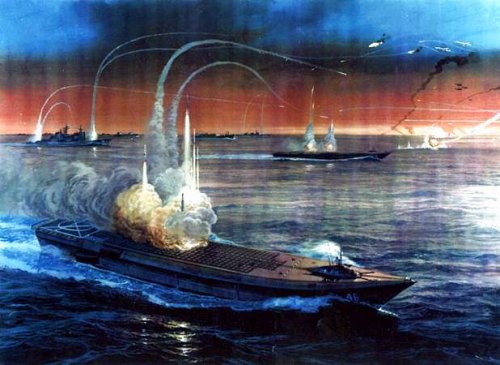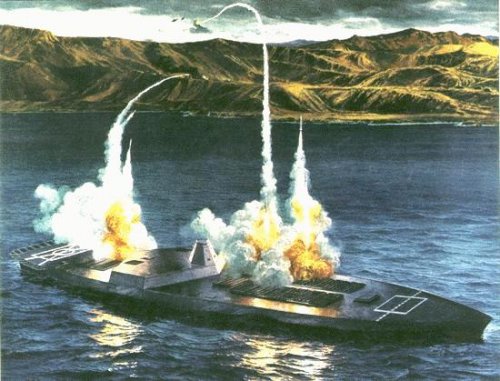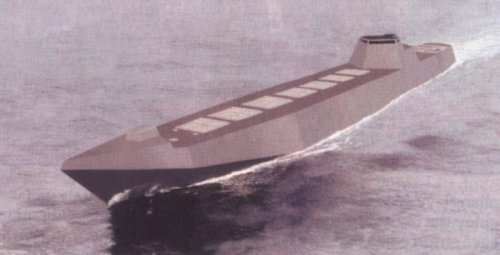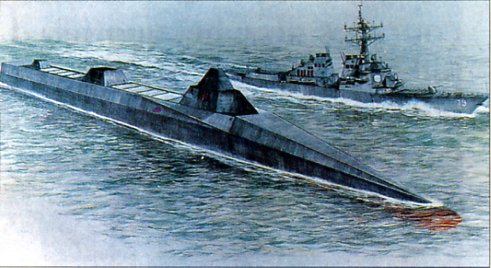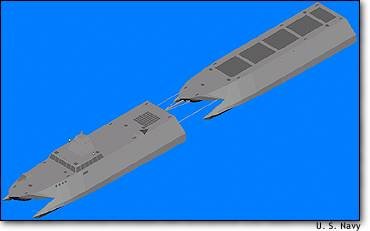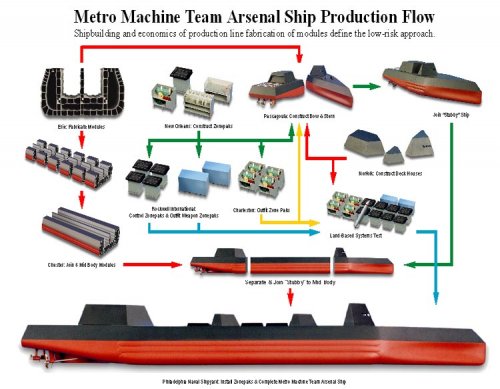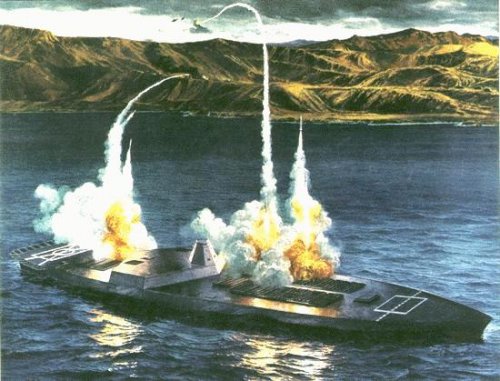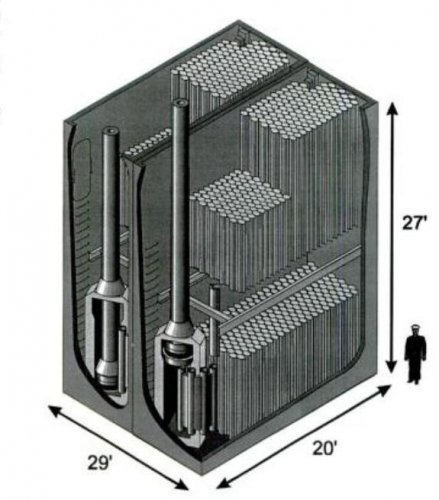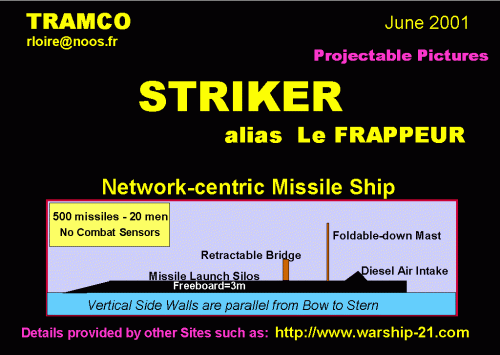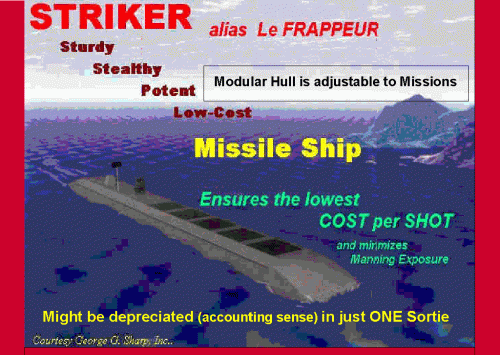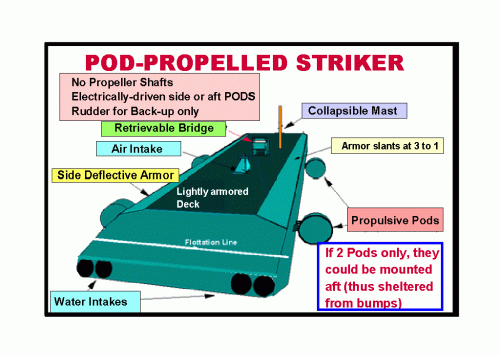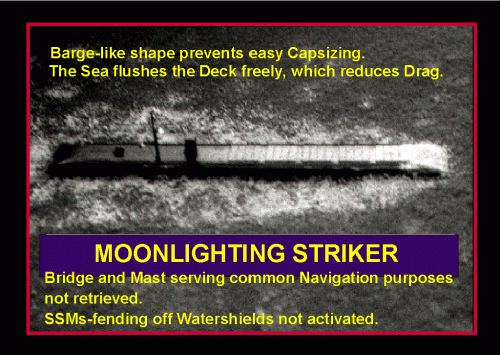You are using an out of date browser. It may not display this or other websites correctly.
You should upgrade or use an alternative browser.
You should upgrade or use an alternative browser.
Several Arsenal ship concepts
- Thread starter sferrin
- Start date
Sentinel Chicken
American 71 Heavy, contact departure 126.47
Some of those low-freeboard versions of the Arsenal Ship remind me a lot of the ironclads from the US Civil War! If I remember right, some of the designs had a variable freeboard where ballast tanks could raise or lower the ship's profile in the water to present less of a target when in the combat zone.
- Joined
- 3 January 2006
- Messages
- 967
- Reaction score
- 407
pometablava said:Arsenal Ship: La Nave in Rete by Andrea Prati. Italian magazine Panorama Difesa. Ottobre 1996
I realy like the "bottle shaped" deck plan, so obviously influenced by the Iowa class battleships. Oddly enough, the AOE-type Sacramento class replenishment ships also had a hull form similar to the Iowas - and the first two units each had half the machinery from the cancelled USS Kentucky.
I do have to wonder if this sort of complex design would conform with modern shipbuilding practices? Is this an actual proposal? Of course, some of the details, such as the bridge design, do conform to later designs such as the current Lockheed LCS?
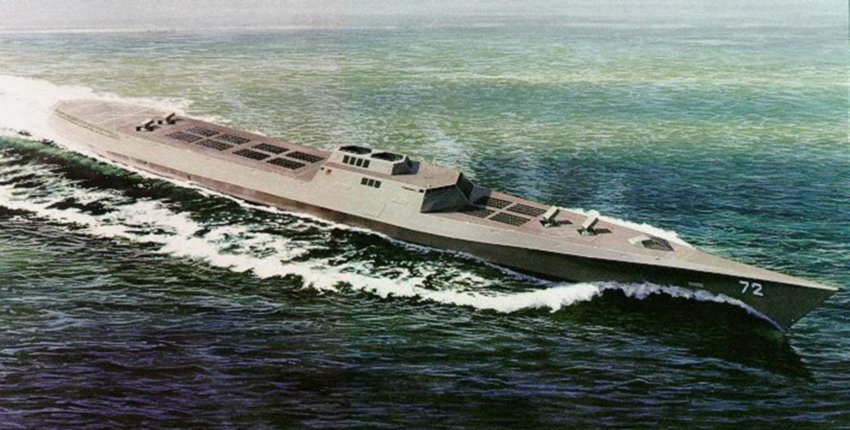
- Joined
- 3 January 2006
- Messages
- 967
- Reaction score
- 407
Brickmuppet
ACCESS: Secret
Does anyone know what the box launcher-like objects visible in replies 3&4 are?
Also, any ideas on dimensions?
Also, any ideas on dimensions?
canisd
ACCESS: Restricted
Add a smokestack and the stars n' bars to the flag pole and most of these arsenal ships would have a stunning resemblance to a Confederate ironclad like the Albemarle.
Brickmuppet said:Does anyone know what the box launcher-like objects visible in replies 3&4 are?
I believe they were RAM launchers that could retract into the hull for stealth.
The box-launchers are too large to be RAM - they are GMLRS.
Funny thing is that the German Navy is planning to fit a navilised MLRS to its' next class of frigate.
RP1
Funny thing is that the German Navy is planning to fit a navilised MLRS to its' next class of frigate.
RP1
thewanderingmind
Werfless
- Joined
- 2 August 2006
- Messages
- 25
- Reaction score
- 6
TinWing said:
;DThanks for the link, TinWing! Looking at this, I think they've got the right idea! It's just getting the deadheads at DoD to grasp the concept that's the problem! This concept would work for a lot more than just arsenal ships, and the way they've got the process worked out is astoundingly clever. I love the "stubby" concept -- moving the bow and stern as a vessel by sea to the point they add the midships modules. This would work for our US vessels -- and a consortium of Euro/NATO shipbuilders could monopolize Europe's naval defense buys by spreading the work around like this. Sort of a seagoing Airbus...
Metro Machine Arsenal Ship concept:
http://www.memach.com/nuhm/arsenal.htm
What do people think of the ZonePak mission-module concept and ships that are mission-configurable swapping in and out modules based on requirements? Is this better than building additional dedicated ships?
http://www.memach.com/nuhm/arsenal.htm
What do people think of the ZonePak mission-module concept and ships that are mission-configurable swapping in and out modules based on requirements? Is this better than building additional dedicated ships?
Attachments
I like the concept of the modular design by Metro Machine Team. What I have observed from naval history is that when hostilities start, you can never build enough ships to replenish the ones you lost. With their design you could have several types of vessels that can be build from a common hull. Another point is that the bow and stern can be separated from the hull. You could remove damaged parts from the vessel and attach new ones. I would love to see this concept developed where you could repair/refit a vessel out on the high seas.
Lauge
ACCESS: Secret
- Joined
- 30 January 2008
- Messages
- 434
- Reaction score
- 46
Triton said:Metro Machine Arsenal Ship concept:
http://www.memach.com/nuhm/arsenal.htm
What do people think of the ZonePak mission-module concept and ships that are mission-configurable swapping in and out modules based on requirements? Is this better than building additional dedicated ships?
Some years ago, the Danish Navy designed the Standard Flex 300 series of patrol ships (some have now been donated to Lithuania, I believe): http://www.navalteam.dk/ships/std_flex_concept.aspx
These ships used interchangeable mission modules that allowed each hull to serve as a fisheries protection ship, a patrol ship, a missile boat, an environmental protection vessel etc. Good ships, although a wee bit small for sustained blue-water operations. The same concept is applied to the two new frigate-size Command Support Ships, HDMS Absalon and HDMS Esbern Snarre. They use a so-called "flex-deck" design, where the rear lower-deck area of the ship can be configured for troop and materiel transport, command & control, field hospital, etc.
Regards & all,
Thomas L. Nielsen
Denmark
Arsenal Ship Master's Thesis by LT Dawn H. Driesbach, USN:
http://www.fas.org/man/dod-101/sys/ship/docs/rsnlship.htm
http://www.fas.org/man/dod-101/sys/ship/docs/rsnlship.htm
I've seen that idea of a common bow and stern with an interchangable mid section (cargo section) applied to merchant ship concepts.
Interesting idea but how well would it cope in extreme seas, after all standard ships do have problems.
Edit, just realised, they are not interchangable, it just a modular construction method.
Interesting idea but how well would it cope in extreme seas, after all standard ships do have problems.
Edit, just realised, they are not interchangable, it just a modular construction method.
If the arsenal ship had been built, would it have been designated a battleship (BB)? Or was it presumptuous of the concept artist to give the ship a pennant number of 72? USS Montana (BB-72)? A total of six ships were planned. Could these ships also be logically designated as guided missile strike cruisers (CSG)?
- Joined
- 16 April 2008
- Messages
- 8,388
- Reaction score
- 10,311
Had Arsenal Ship gone forward, it is very unlikely that it would have received either battleship or cruiser designations -- the Navy was at great pains to emphasize that it was not a fully functional warship (it had no sensors to speak of beyond those needed for navigation and could not launch weapons without external control from another platform). Most likely it would have been designated as an auxiliary ship, in keeping with the Navy's preference for treating it as a floating magazine -- in effect an ammunition ship that did not have to offload its ordnance to another vessel before firing it. The other leading option would be to class it as an amphibious ship, due to its fire support role. Here are some possibilities that seem plausible to me:
LFS: fire support ship -- an existing designation, historically used for much smaller designs aimed specifically for amphibious landing support
AA or AAS: Auxiliary Arsenal Ship -- like LCS for Littoral Combat Ship, the Navy these days is happy to invent new designations that look like acronyms
AM: Auxiliary missile ship -- AG is taken (misc. auxiliary), and G for guided missile would imply fire control capabilities that Arsenal Ship lacked anyway
AEM: ammunition ship, missile -- based on the ammunition ship idea, this parallels the old AVM designation for the missile test ship Norton Sound
LFS: fire support ship -- an existing designation, historically used for much smaller designs aimed specifically for amphibious landing support
AA or AAS: Auxiliary Arsenal Ship -- like LCS for Littoral Combat Ship, the Navy these days is happy to invent new designations that look like acronyms
AM: Auxiliary missile ship -- AG is taken (misc. auxiliary), and G for guided missile would imply fire control capabilities that Arsenal Ship lacked anyway
AEM: ammunition ship, missile -- based on the ammunition ship idea, this parallels the old AVM designation for the missile test ship Norton Sound
I really like the Auxiliary Ammunition Missile (AEM) designation for this type of ship with EM 1 painted on the side of the first ship since it is essentially a floating missile magazine. I also like the idea of naming these ships for active volcanoes within the United States continuing the naming convention of the ammunition ships currently in service.
Arsenal Ship minimal manning developed by the Defense Advanced Research Projects Agency (DARPA):
1 Commanding Officer
1 Executive Officer
Operations
------------------
1 Operations Officer
3 Quartermasters
1 Cook
1 Mess Specialist
3 Communications Technicians
Engineering
-------------------
1 Engineering Officer
1 Damage Control/Maintenance Officer
3 Enginemen
2 Maintenance Technicians
2 Electricians
1 Fireman
Weapons Support
-----------------
1 Weapons Officer
1 Fire Control Technicians
2 Missile Technicians
Image is an artist's view of a Northrop Grumman Arsenal Ship concept launching strike missiles against land targets. This view shows a ship with 500 vertically launched land-attack and air-defense missiles. The ship has a stealth configuration, with a Vertical Replenishment (VERTREP) deck forward and helicopter deck aft.
Source: The Naval Institute Guide to Ships and Aircraft of the US Fleet, Seventeenth Edition by Norman Polmar.
1 Commanding Officer
1 Executive Officer
Operations
------------------
1 Operations Officer
3 Quartermasters
1 Cook
1 Mess Specialist
3 Communications Technicians
Engineering
-------------------
1 Engineering Officer
1 Damage Control/Maintenance Officer
3 Enginemen
2 Maintenance Technicians
2 Electricians
1 Fireman
Weapons Support
-----------------
1 Weapons Officer
1 Fire Control Technicians
2 Missile Technicians
Image is an artist's view of a Northrop Grumman Arsenal Ship concept launching strike missiles against land targets. This view shows a ship with 500 vertically launched land-attack and air-defense missiles. The ship has a stealth configuration, with a Vertical Replenishment (VERTREP) deck forward and helicopter deck aft.
Source: The Naval Institute Guide to Ships and Aircraft of the US Fleet, Seventeenth Edition by Norman Polmar.
Attachments
The Arsenal Ship may have been armed with the Vertical Gun for Advanced Ships (VGAS). Twin 155-mm guns--with a range of about 100 nm (185 km)--and their magazines were to be fitted in a modular mounting that would replace a standard 64-cell Vertical Launching System (VLS).
The gun system was to be fully automated, with 1,400 rounds per module. Projectiles up to 6.5 feet (1.9m) long and weighing 300 lbs. (136 kg) could be handled by VGAS. The sustained rate of fire was to be 15 rounds per minute per barrel.
The VGAS evolved into the 155mm Advanced Gun System (AGS) developed for the Zumwalt-class destroyer.
Source: The Naval Institute Guide to Ships and Aircraft of the US Fleet, Seventeenth Edition by Norman Polmar.
The gun system was to be fully automated, with 1,400 rounds per module. Projectiles up to 6.5 feet (1.9m) long and weighing 300 lbs. (136 kg) could be handled by VGAS. The sustained rate of fire was to be 15 rounds per minute per barrel.
The VGAS evolved into the 155mm Advanced Gun System (AGS) developed for the Zumwalt-class destroyer.
Source: The Naval Institute Guide to Ships and Aircraft of the US Fleet, Seventeenth Edition by Norman Polmar.
Attachments
Demon Lord Razgriz
ACCESS: Confidential
- Joined
- 31 October 2008
- Messages
- 189
- Reaction score
- 8
I've never seen much on how the VGAS works, does the the barrel come up to fire or what? ???
- Joined
- 18 March 2008
- Messages
- 3,532
- Reaction score
- 722
On VGAS the barrels are fixed and do not elevate or train. The system is designed to only fire guided rounds like the BAE Systems 155mm Long Range Land Attack Projectiles (LRLAP). These rounds only need to be fired straight up and into the air and will turn and guide themselves to targets on any bearing (360 degrees).
It was a great disaster for the US Navy and allies that VGAS was turned into AGS on the whim of an Admiral. Just so the new 155mm gun could fire conventional ammunition, of course the cost of developing a trainable turret meant there was no money to develop the conventional ammunition it could fire and the resulting system (AGS) was so big and heavy you needed a special ship to carry it.
You can read more about how VGAS works in this paper on a submarine mounted version: the Compact Vertical Gun System (CVGS) proposal for the Ohio SSGN conversion.
www.dtic.mil/ndia/gun/martin.pdf
It was a great disaster for the US Navy and allies that VGAS was turned into AGS on the whim of an Admiral. Just so the new 155mm gun could fire conventional ammunition, of course the cost of developing a trainable turret meant there was no money to develop the conventional ammunition it could fire and the resulting system (AGS) was so big and heavy you needed a special ship to carry it.
You can read more about how VGAS works in this paper on a submarine mounted version: the Compact Vertical Gun System (CVGS) proposal for the Ohio SSGN conversion.
www.dtic.mil/ndia/gun/martin.pdf
Abraham Gubler said:You can read more about how VGAS works in this paper on a submarine mounted version: the Compact Vertical Gun System (CVGS) proposal for the Ohio SSGN conversion.
www.dtic.mil/ndia/gun/martin.pdf
Abraham, the link doesn't seem to work.
- Joined
- 18 March 2008
- Messages
- 3,532
- Reaction score
- 722
Lockheed Martin brochure for the Long Range Land Attack Projectile.
http://www.lockheedmartin.com/data/assets/mfc/Photos/MFC_LRLAP_product_card.pdf
http://www.lockheedmartin.com/data/assets/mfc/Photos/MFC_LRLAP_product_card.pdf
- Joined
- 18 March 2008
- Messages
- 3,532
- Reaction score
- 722
Here is video of how an LRAP round can effect the battlefield. If VGAS rather than AGS had gone ahead this kind of naval gunfire support (NGS) capability would be available to any hull able to carry a 64 cell Mk 41 strike length VLS.
http://www.youtube.com/watch?v=ilwIhIwf5yI
http://www.youtube.com/watch?v=ilwIhIwf5yI
I thought that this report from the Rand Corporation was interesting.
The Arsenal Ship Acquisition Process Experience by Robert S Leonard et al., RAND NATIONAL DEFENSE RESEARCH INST SANTA MONICA CA (Jan 1999)
Handle / proxy Url: http://handle.dtic.mil/100.2/ADA365150
The Arsenal Ship Acquisition Process Experience by Robert S Leonard et al., RAND NATIONAL DEFENSE RESEARCH INST SANTA MONICA CA (Jan 1999)
The Arsenal Ship acquisition program was unique in two respects: it represented a new operational concept for Navy ships, and its management structure and process were different from traditional military ship-building programs. The Arsenal Ship program was, in effect, an experiment in both product and process. Three specific goals of the program were outlined at its inception: demonstrate the capability affordably; leverage commercial practices and technologies; and, demonstrate the reformed acquisition process. This research focuses on the program's acquisition strategy.
Handle / proxy Url: http://handle.dtic.mil/100.2/ADA365150
Below is an article I just came across :
Maritech wave-piercing hull may be proposed for arsenal ship
by John Bosma
Defense Daily / April 12, 1996
A radical new monohull being developed under the Defense Advanced Research Projects Agency MARITECH (Maritime Technology) program may be proposed for the Navy/DARPA "arsenal ship" program, according to industry officials.
According to a program source, a high-speed wave-piercing MARITECH monohull from an industry team of General Dynamics' Bath Iron Works Div. and Norway's Kvaerner-Masa Marine may be an entrant in the arsenal ship design competition. For MARITECH, the BIW/KMM team has studied a 43,000-ton, 800- foot wave-piercer carrying 20,000 tons of containers.
The wave-piercer concept originated from KMM's Finnish yards, where it has undergone extensive tank and open-water testing. The wave-piercer is a very slender hull with a knifelike bow that slices through waves rather than riding over them, as more heavily constructed bows on conventional ships are designed to do.
KMM calls the wave-piercer "breakthrough technology." It says wave-piercer cargo liners could run efficiently at 30-35 knots, using 120,000 shaft horsepower, in transatlantic winter seas, considered the industry's benchmark for the toughest operating conditions. Even higher speeds are possible with more horsepower.
By contrast, today's containerships now run 23-25 knots, with the latest containerships reaching 27 knots. Industry experts say that over 50 percent of transatlantic containership crossings run behind schedule, mostly due to weather.
These speed figures suggest that a wave-piercer arsenal ship would be faster than most Navy surface ships. The low crew manning that the Navy seeks for arsenal ships would mesh with the sharply reduced crews required by modern commercial vessels.
MARITECH is a five-year, $220 million DARPA/Department of Commerce-Maritime Administration program to improve U.S. shipbuilding processes and ship design. It comes under the Clinton administration's five-year National Shipbuilding Initiative, begun in FY 94.
Source
- Joined
- 9 October 2009
- Messages
- 19,925
- Reaction score
- 10,434
Matt R. said:Some pics of Rene Loire's proposed Striker.
Opinions on the hull form (barge-like) chosen ?
Seems like it would have been (and still would be) quite cost effective.
sferrin said:The Ohio SSGNs are pretty much taking up this role (minus the SAMs)
Not necessarily. SSGNs are not by definition readily expendable, and they have a much smaller loadout (with less options) than an arsenal ship design would.
- Joined
- 3 June 2011
- Messages
- 17,331
- Reaction score
- 9,059
Grey Havoc said:Not necessarily. SSGNs are not by definition readily expendable, and they have a much smaller loadout (with less options) than an arsenal ship design would.
You think an Arsenal Ship loaded up with more cells than an SSGN would be "readily expendable"? Good one. ;D
- Joined
- 26 September 2008
- Messages
- 1,925
- Reaction score
- 639
sferrin said:You think an Arsenal Ship loaded up with more cells than an SSGN would be "readily expendable"? Good one. ;D
Way back when the Arsenal Ship was first being proposed the US Navy held an "industry day" in Washington to discuss it. They handed out 3-ring binders with info on the proposal. I got one, but I think I threw it out not long afterwards because it really wasn't all that interesting. (Typical contractor specs listing all the requirements for submitting a contract--how many copies had to be submitted, how big the paper had to be, what the due dates were. Almost nothing about the actual requirements for the weapons system. Boring boring boring. No illustrations either.)
Anyway, going to that meeting was really rather weird. There were a lot of military contractors there to find out what the Navy wanted for an Arsenal Ship. But just listening to the presentations it was clear that this project was never going to get anywhere and they were never going to build the ship. I heard people discussing it in the hallways and they were talking about how nutty it was. For one thing, it was going to require something like 90% of the cruise missiles then in the Navy's inventory. And I think there was discussion of building only two of them, one in the Atlantic and one in the Pacific.
Recently the Navy's LCS has come under criticism because there was no clearly stated need for the ships and the Navy is trying to figure out what they will actually be good at. The Arsenal Ship was a more extreme example of what's happening with LCS and proof that the Navy should never let an admiral push through a pet idea without it being rigorously reviewed first.
- Joined
- 9 October 2009
- Messages
- 19,925
- Reaction score
- 10,434
sferrin said:Grey Havoc said:Not necessarily. SSGNs are not by definition readily expendable, and they have a much smaller loadout (with less options) than an arsenal ship design would.
You think an Arsenal Ship loaded up with more cells than an SSGN would be "readily expendable"? Good one. ;D
Yes, I do, especially with regards as to the crew. Not to mention being much cheaper than either a SSGN conversion or new build (in terms of both construction and overall operating costs).
blackstar, by any chance was the author of this one of those who took part in the industry day you were at, do you remember?
Proposed Littoral Dominant Battle Group Centered Around The Arsenal Ship
CCS 1997
Subject Area - Warfighting
Executive Summary
Title: A Proposed Littoral Dominant Battle Group Centered Around The Arsenal Ship
Author: Lieutenant Commander John P. Looney, United States Navy
Thesis: For the projected $500 million investment in a demonstrator Arsenal Ship, the Navy will likely get what it is asking for, a ship designed to help the aircraft carrier battle group make the transition from a blue-water dominant team to a littoral dominant team. Just as the Navy built the aircraft carrier battle group team and doctrine to dominate the blue-water for the past 50 plus years, the Navy now needs to build the team and the doctrine that can dominate the littoral battle space of the 21st century. The Arsenal Ship concept should center around having industry build a ship that could be the centerpiece of a littoral dominant battle group.
Background: The United States Navy has shifted its strategic focus from the blue-water to the littorals; therefore, it would make sense for the Navy to develop doctrine and force structure to dominate the littorals. The Navy is in the process of building a revolutionary new class of warship--Arsenal Ship. The Arsenal Ship's operational concept is focused on a ship that will enhance the fire power of existing aircraft carriers, land attack capable combatants and submarines. In this period of austere funding and downsizing, the Navy must look not only to new technologies but to new organizations and doctrine to effectively and efficiently meet its mandated missions. There are two areas where shortfalls exist to building a littoral dominant team: 1) the Navy does not have a staff that is organized and trained to plan and execute littoral dominance operations; and 2) the Navy has critical shortfalls in naval surface fire support assets.
Recommendations: The United States Navy should build a littoral dominant battle group centered around the Arsenal Ship: a typical aircraft carrier battle group with an Arsenal Ship in the place of the aircraft carrier, and an Amphibious Group (PHIBGRU) commander leading it instead of a Carrier Group (CARGRU) or Cruiser Destroyer Group (CRUDESGRU) commander. An Arsenal Ship Battle Group, led by an experienced littoral warfare expert, would be a viable forward presence and power projection entity; furthermore, it would be an effective building block for follow-on forces if a large-scale crisis were to develop.
Similar threads
-
-
-
-
-
Arsenal de l'Aéronautique ("Arsenal") designations
- Started by Apophenia
- Replies: 26

